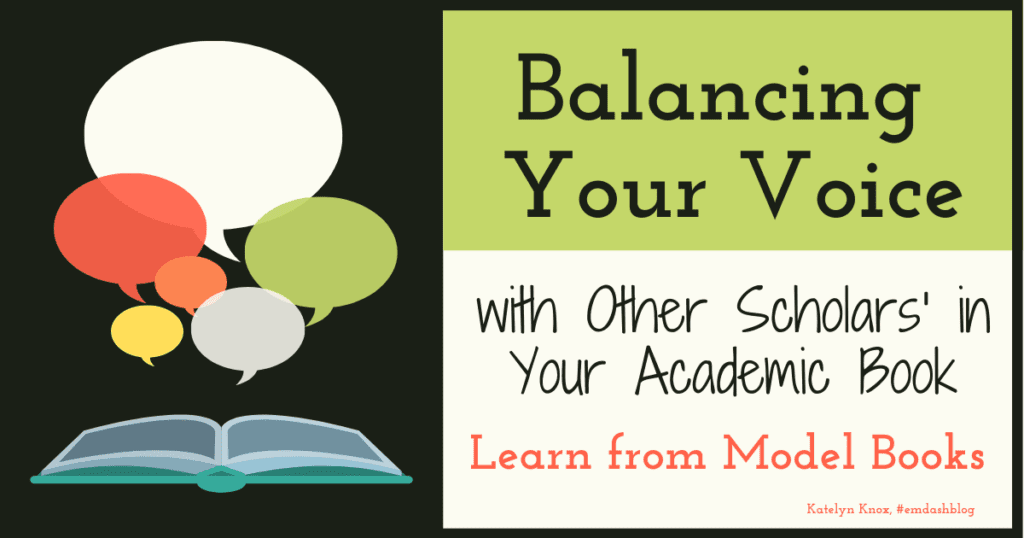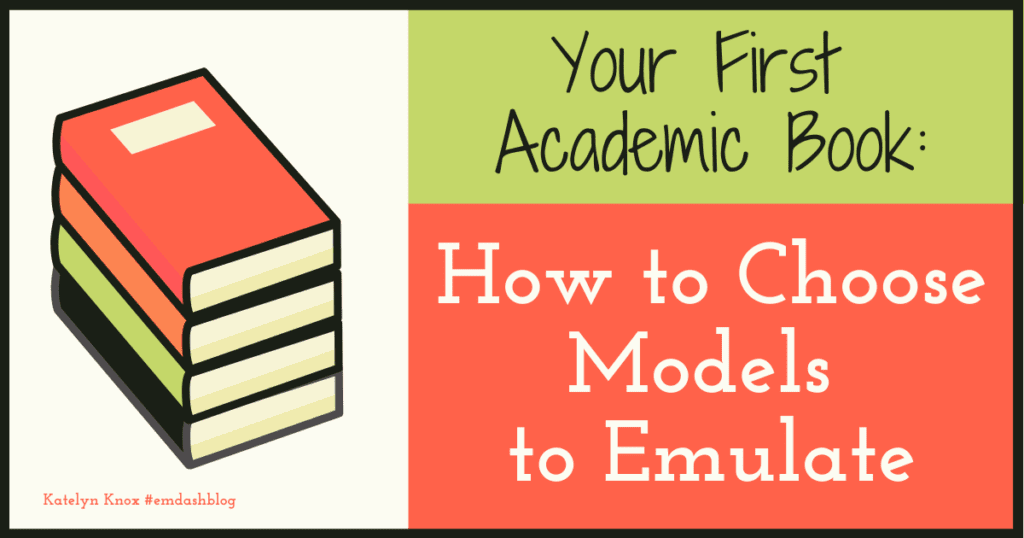William Germano, author of From Dissertation to Book, asserts that books originating out of dissertations struggle to shake “dissertation style.” Beyond stylistic tendencies like passive voice, first book authors, he contends, are rarely able to foreground their voice while engaging with existing scholarship. All too often, their voice gets lost in the shuffle.
I knew this was true of my own dissertation, and worried it would mar my first book. Armed with the knowledge of what not to do, though, I still didn’t know exactly what balance I was aiming for in my first book.
In this post, I guide you through targeted activities to do just that.
Specifically, I teach you to:
- learn where most first book authors go wrong when it comes to balancing their voice with others’ in their first book manuscript and how to engage others’ scholarship without losing your own voice
- determine how other scholars in your field strike this balance
- evaluating how well your own book manuscript fits your field’s conventions
For a fuller explanation of the reasoning behind this advice, see Chapter 16 (“Citing with Confidence”) of The Dissertation-to-Book Workbook.

Learning What to Avoid in Engaging Other Scholarship and How to Foreground Your Voice
Step 1: Read Germano & The Dissertation-to-Book Workbook
To learn what most authors of first books do poorly (that is, what you should avoid), read:
- William Germano’s From Dissertation to Book (FDTB), Chapter 8, sections “‘Dissertation Style’,” “Footnote Madness,” and “One Example Too Many”
- William Germano’s Getting it Published (GIP), Chapter 3, section “Revising the Dissertation,” starting with the paragraph “Dissertations frequently cite far more…”
- Chapter 16 (“Citing with Confidence”) of The Dissertation-to-Book Workbook.
Step 2: Reflect on What to Avoid
- FDTB, Chapter 8, section 1: What traits mark “dissertation style”? Do you think your manuscript exhibits these traits? If so, how do you plan to reduce or eliminate them?
- FDTB, Chapter 8, sections 3-4: What characterizes dissertation footnotes and examples? How can you avoid these features as you revise your dissertation into a book?
- GIP, Chapter 3, section “Revising the Dissertation”: What problems do dissertations-turned-books typically exhibit? Does your book manuscript have these traits? If so, how do you plan to address them?
- D2BWB, Chapter 16: What are the problematic impulses behind why authors cite theory or secondary literature? Do you often engage in them?
Step 3: Read Hayot & The Dissertation-to-Book Workbook
- Learn about how to cite secondary literature skillfully by reading Eric Hayot’s Elements of Academic Style (eBook), Chapter 15: “Showing Your Iceberg,” Chapter 19: “Citational Practice,” and Chapter 23: “Footnotes and Endnotes.”
- Discover quick fixes to make your book instantly sound more book-like in Chapter 16 (“Citing with Confidence”) of The Dissertation-to-Book Workbook.
Step 4: Reflect on Citational Best Practices
- EoAS, Chapter 15: How do you plan to better “show your iceberg,” as Hayot puts it?
- EoAS, Chapter 19: What of the advice in this chapter do you plan to practice as you balance citing other scholars work with crafting your own arguments?
- EoAS, Chapter 23: How did Hayot’s explicit discussion of the dialog between the body text and notes change your understanding of these two textual threads? What material currently presented in your chapters’ bodies should be moved to the notes and vice versa?
- D2BWB, Chapter 16: What are more skillful moves you can make in citing theory and scholarship?
Analyzing Model Books in Your Field to Determine Conventions
Now that you know what to avoid and to aim for in theory, you’re going to study how authors of academic authors in your field balance foregrounding their voice with others’ in practice.
Doing so will require both quantitative and qualitative methods. Though the quantitative piece might seem tedious (especially for humanities-minded folks!), please don’t skip it. Most scholars find it one of the most revelatory and objective points of comparison they can apply to their own book manuscript.
In this section I assume you have already selected at least two model books to analyze.
Step 5: Identify 2 Body Chapters from Each of Your 2 Model Books to Analyze
Armed with the knowledge from Germano and Hayot, skim your two model books’ body chapters–NOT the book’s introduction or conclusion. Identify the two in each book that seem to cite other scholars’ ideas skillfully.
Step 6: Analyze Your 2 Model Books, Quantitatively
Complete the analysis below four times total (once for each body chapter you identified. Remember, you are only interested in how the author cites secondary scholarship, NOT primary sources. Note:
- Total # of secondary sources referenced
- Total # references in body text (not footnotes)
- % of references in body text (#2 ÷ #1)
- Total # of references in footnotes only
- % of references in footnotes only (#4 ÷ #1)
- Total number of block quotes (dissertations and early first book manuscripts tend to have too many!)
- Average # of block quote lines (dissertations and early first book manuscripts tend to have too many!)
- Total # of direct quotes in body prose
- Average # of words of direct quotes in body prose (dissertations and early first book manuscripts tend to have too many!)
- Total # of paraphrases (dissertations and early first book manuscripts tend to have too few, instead favoring direct quoting)
- How many paragraphs’ topic sentences begin with another scholar’s name? (dissertations and early book manuscripts tend to use other voices to start paragraphs, which can read deferentially)
Step 7: Analyze Your 2 Model Books, Qualitatively
For each book chapter, answer the following questions (four times total):
- On the footnote/body text balance: What distinguishes the sources only mentioned in the footnotes from those directly referenced in the body prose? How well does this track with what Hayot proposes in The Elements of Academic Style?
- On the balance between direct citation/block quoting and paraphrasing: What seems to be the balance between block quotation, direct citations, and paraphrasing?
- How well does this chapter contextualize direct and block quotes? What, specifically makes these introductions successful (or not)?
- How well does this chapter avoid the pitfalls outlined by Germano in From Dissertation to Book? How so?
- Note 2-3 moments of citation to emulate in this body chapter. What makes them particularly strong, in your view?
Step 8: Compiling Quantitative Trends for Your Field
Finally, average the data you gathered in Step 6 to see general trends for model books in your field. Though your sample size is small, it is nevertheless a useful beginning point of comparison for your own book.
Evaluating How Your Own Prose Matches up on Voice and Citational Practices
Now, you’ll evaluate how two body chapters in your book manuscript measure up in balancing your voice while engaging other scholarship. You can either select two that are the most polished, two that you believe need the most work, or one of each.
Step 9: Analyze Your Own Book Chapters, Quantitatively
Perform the same quantitative analysis you did in Step 6 on your own book. For reference, here are the data to gather:
- Total # of secondary sources referenced
- Total # references in body text (not footnotes)
- % of references in body text (#2 ÷ #1)
- Total # of references in footnotes only
- % of references in footnotes only (#4 ÷ #1)
- Total number of block quotes (dissertations and early first book manuscripts tend to have too many!)
- Average # of block quote lines (dissertations and early first book manuscripts tend to have too many!)
- Total # of direct quotes in body prose
- Average # of words of direct quotes in body prose (dissertations and early first book manuscripts tend to have too many!)
- Total # of paraphrases (dissertations and early first book manuscripts tend to have too few, instead favoring direct quoting)
- How many paragraphs’ topic sentences begin with another scholar’s name? (dissertations and early book manuscripts tend to use other voices to start paragraphs, which can read deferentially)
Step 10: Analyze Your Own Book Chapters, Qualitatively
Here, perform a broader qualitative analysis than you did in Step 7 above. Ask:
- How well do you balance your voice and others’ in this chapter? Does your voice drive the chapter, or does it get lost in the shuffle?
- Given what you learned by analyzing model books in the systematic way outlined above, how well do you balance paraphrasing, direct citation, and block quotes in this chapter?
- What 1-3 areas regarding secondary citation should you target when revising this chapter?
Step 11: Comparing Quantitative Trends
Now for the piece that tends to be the most revelatory. Average the data on the two chapters you gathered on your own book in Step 9 above. Then, compare them to the averages for your model books you compiled in Step 8.
Reflect on how well your current book manuscript aligns with the trends published monographs in your field exhibit:
- In what ways does your book depart from norms in your field? Are these acceptable or will you need to address them through revision?
Review & Reflect on How to Foreground Your Voice While Engaging Scholarship
I hope that this systematic approach to studying how other book authors balance their voice and others’ has given you new insight into how, concretely, to do this in your own book.
But to ensure you benefit from these lessons in your scholarly writing, take time to review and synthesize the lessons you’ve learned while they’re still fresh in your mind.
- How has reading Hayot, Germano, and The Dissertation-to-Book Workbook and analyzing others’ monographs changed your understanding of how to cite others while foregrounding your voice?
- How has reviewing others’ scholarship in this way allowed you to understand book conventions in your field better?
- How has this exercise clarified differences between dissertations and books?
Finally, these lessons won’t do much unless you deliberately practice what you learned. So, make a plan:
- Which 1-3 elements (large or small) about how you engage secondary literature which, if improved, would make the biggest impact on your scholarly writing, generally speaking?
- How, concretely, do you plan to practice the elements you noted in the previous answer in the coming weeks and months?


